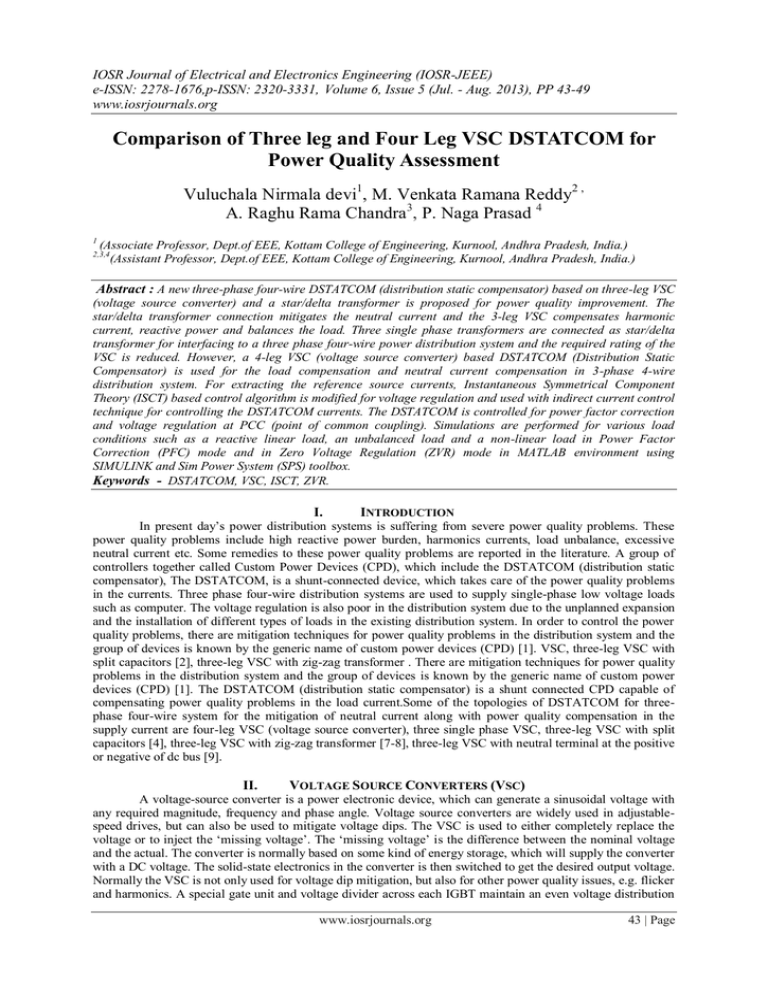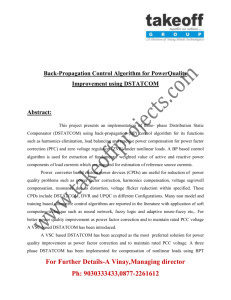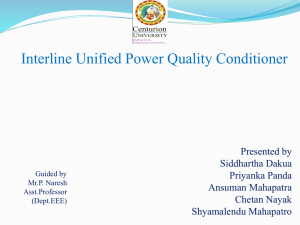Comparison of Three leg and Four Leg VSC DSTATCOM for
advertisement

IOSR Journal of Electrical and Electronics Engineering (IOSR-JEEE) e-ISSN: 2278-1676,p-ISSN: 2320-3331, Volume 6, Issue 5 (Jul. - Aug. 2013), PP 43-49 www.iosrjournals.org Comparison of Three leg and Four Leg VSC DSTATCOM for Power Quality Assessment Vuluchala Nirmala devi1, M. Venkata Ramana Reddy2 , A. Raghu Rama Chandra3, P. Naga Prasad 4 1 (Associate Professor, Dept.of EEE, Kottam College of Engineering, Kurnool, Andhra Pradesh, India.) (Assistant Professor, Dept.of EEE, Kottam College of Engineering, Kurnool, Andhra Pradesh, India.) 2,3,4 Abstract : A new three-phase four-wire DSTATCOM (distribution static compensator) based on three-leg VSC (voltage source converter) and a star/delta transformer is proposed for power quality improvement. The star/delta transformer connection mitigates the neutral current and the 3-leg VSC compensates harmonic current, reactive power and balances the load. Three single phase transformers are connected as star/delta transformer for interfacing to a three phase four-wire power distribution system and the required rating of the VSC is reduced. However, a 4-leg VSC (voltage source converter) based DSTATCOM (Distribution Static Compensator) is used for the load compensation and neutral current compensation in 3-phase 4-wire distribution system. For extracting the reference source currents, Instantaneous Symmetrical Component Theory (ISCT) based control algorithm is modified for voltage regulation and used with indirect current control technique for controlling the DSTATCOM currents. The DSTATCOM is controlled for power factor correction and voltage regulation at PCC (point of common coupling). Simulations are performed for various load conditions such as a reactive linear load, an unbalanced load and a non-linear load in Power Factor Correction (PFC) mode and in Zero Voltage Regulation (ZVR) mode in MATLAB environment using SIMULINK and Sim Power System (SPS) toolbox. Keywords - DSTATCOM, VSC, ISCT, ZVR. I. INTRODUCTION In present day‟s power distribution systems is suffering from severe power quality problems. These power quality problems include high reactive power burden, harmonics currents, load unbalance, excessive neutral current etc. Some remedies to these power quality problems are reported in the literature. A group of controllers together called Custom Power Devices (CPD), which include the DSTATCOM (distribution static compensator), The DSTATCOM, is a shunt-connected device, which takes care of the power quality problems in the currents. Three phase four-wire distribution systems are used to supply single-phase low voltage loads such as computer. The voltage regulation is also poor in the distribution system due to the unplanned expansion and the installation of different types of loads in the existing distribution system. In order to control the power quality problems, there are mitigation techniques for power quality problems in the distribution system and the group of devices is known by the generic name of custom power devices (CPD) [1]. VSC, three-leg VSC with split capacitors [2], three-leg VSC with zig-zag transformer . There are mitigation techniques for power quality problems in the distribution system and the group of devices is known by the generic name of custom power devices (CPD) [1]. The DSTATCOM (distribution static compensator) is a shunt connected CPD capable of compensating power quality problems in the load current.Some of the topologies of DSTATCOM for threephase four-wire system for the mitigation of neutral current along with power quality compensation in the supply current are four-leg VSC (voltage source converter), three single phase VSC, three-leg VSC with split capacitors [4], three-leg VSC with zig-zag transformer [7-8], three-leg VSC with neutral terminal at the positive or negative of dc bus [9]. II. VOLTAGE SOURCE CONVERTERS (VSC) A voltage-source converter is a power electronic device, which can generate a sinusoidal voltage with any required magnitude, frequency and phase angle. Voltage source converters are widely used in adjustablespeed drives, but can also be used to mitigate voltage dips. The VSC is used to either completely replace the voltage or to inject the „missing voltage‟. The „missing voltage‟ is the difference between the nominal voltage and the actual. The converter is normally based on some kind of energy storage, which will supply the converter with a DC voltage. The solid-state electronics in the converter is then switched to get the desired output voltage. Normally the VSC is not only used for voltage dip mitigation, but also for other power quality issues, e.g. flicker and harmonics. A special gate unit and voltage divider across each IGBT maintain an even voltage distribution www.iosrjournals.org 43 | Page Comparison of Three leg and Four Leg VSC DSTATCOM for Power Quality Assessment across the series connected IGBTs. The gate unit not only maintains proper voltage sharing within the valve during normal switching conditions but also during system disturbances and fault conditions. A reliable short circuit failure mode exists for individual IGBTs within each valve position. Depending on the converter rating, series-connected IGBT valves are arranged in either a three-phase two-level or three-level bridge. In three-level converters, IGBT valves may also be used in place of diodes for neutral point clamping. Each IGBT position is individually controlled and monitored via fiber optics and equipped with integrated antiparallel, free-wheeling diodes. Each IGBT has a rated voltage of 2.5 kV with rated currents up to 1500 A. Each VSC station is built up with modular valve housings which are constructed to shield electromagnetic interference (EMI). The valves are cooled with circulating water and water to air heat exchangers. PWM switching frequencies for the VSC typically range between 1-2 kHz depending on the converter topology, system frequency and specific application. Fig.1 Schematics of proposed 3-leg VSC with star/delta transformer based DSTATCOM in distribution system. Fig.1(a) shows the proposed DSTATCOM consisting of three-leg VSC and a star/delta transformer. The DSTATCOM can be operated for reactive power compensation in the mode of power factor correction or voltage regulation. Fig.1(b) shows the phasor diagram for the unity power factor operation. The DSTATCOM injects a current Ic such that the supply current is only Is and this is in phase with voltage. The voltage regulation operation of DSTATCOM is depicted in the phasor diagram of Fig. 1(c). The DSTATCOM injects a current Ic such that the voltage at the load (VS) is equal to the source voltage (VM). The DC capacitor connected at the dc bus of the VSC acts as an energy buffer and establishes a dc voltage for the normal operation of the DSTATCOM system. The star/delta transformer is connected in shunt with the load and this is working as a neutral current compensator. A ripple filter is used at the point of common coupling (PCC) for reducing the high frequency ripple voltage in the voltage at PCC. The high frequency ripple voltage is due to the switching current of the VSC of the DSTATCOM. www.iosrjournals.org 44 | Page Comparison of Three leg and Four Leg VSC DSTATCOM for Power Quality Assessment III. CONTROL OF DSTATCOM The control approaches available for the generation of reference source currents for the control of VSC of DSTATCOM for three-phase four-wire system are instantaneous reactive power theory (IRPT), synchronous reference frame theory (SRFT), unity power factor (UPF) based, instantaneous symmetrical components based, etc. [12], [13]. The SRFT is used in this investigation for the control of the DSTATCOM. A block diagram of the control scheme is shown in Fig. 4. The load currents (iLa, iLb, iLc), the PCC voltages (VSa , VSb , VSc), and dc bus voltage (Vdc) of DSTATCOM are sensed as feedback signals. The load currents from the a–b–c frame are first converted to the α–β–o frame and then to the d–q–o frame using where cos θ and sin θ are obtained using a three-phase phase-locked loop (PLL). A PLL signal is obtained from terminal voltages for generation of fundamental unit vectors [18] for conversion of sensed currents to the d–q–o reference frame. The SRF controller extracts dc quantities by a low-pass filter, and hence, the non-dc quantities (harmonics) are separated from the reference signal. The d-axis and q-axis currents consist of fundamental and harmonic components as Fig 2. Control algorithm for the three leg VSC based DSTATCOM in a three phase four –wire system. IV. MODELING AND SIMULATION The three-leg VSC and the Phase-Shifting Transformer based DSTATCOM connected to a three-phase four-wire system is modeled and simulated using the MATLAB with its Simulink and PSBs. The ripple filter is connected to the DSTATCOM for filtering the ripple in the PCC voltage. The MATLAB-based model of the three-phase four-wire DSTATCOM is shown in the Fig.5. The Phase-Shifting transformer in parallel to the load, the three-phase source, and the shunt-connected three-leg Voltage Source Converter are connected as shown in the Fig.5. The available model of Zigzag Phase-Shifting transformer is used for modeling the Zigzag-delta configuration of the Phase-Shifting transformer. The control algorithm for the DSTATCOM is also modeled in MATLAB. The reference source currents are derived from the sensed PCC voltages (Vsa, Vsb, Vsc), load currents (iLa, iLb, iLc) and the dc bus voltage of DSTATCOM (Vdc). A PWM current controller is used over the reference and sensed source currents to generate the gating signals for the IGBTs of the VSC of the DSTATCOM. www.iosrjournals.org 45 | Page Comparison of Three leg and Four Leg VSC DSTATCOM for Power Quality Assessment Fig 3. MATLAB model of the Zigzag-delta configuration of the Phase-Shifting transformer and the three-leg www.iosrjournals.org 46 | Page Comparison of Three leg and Four Leg VSC DSTATCOM for Power Quality Assessment Fig 4. MATLAB model of the fou-leg VSC DSTATCOM Fig 5. PCC Voltage(V) www.iosrjournals.org 47 | Page Comparison of Three leg and Four Leg VSC DSTATCOM for Power Quality Assessment Fig 6. Source current Fig 7. Load current Fig 8. Source neutral current www.iosrjournals.org 48 | Page Comparison of Three leg and Four Leg VSC DSTATCOM for Power Quality Assessment Fig 9. Compensator –neutral current Fig 10. DC Bus Voltage V. Conclusion The performance of a new topology of four-leg VSC DSTATCOM has been demonstrated for reactive power compensation, harmonic elimination, load balancing and mitigating circulating power flows in interconnected utilities. . The dc bus voltage of the DSTATCOM has been regulated to the reference dc bus voltage under varying loads. As comparison made in term of costs, Zigzag-delta Phase-Shifting transformers show that low cost as to compare with active filter and other types of harmonic mitigation. REFERENCES [1] [2] [3] [4] [5] [6] [7] [8] [9] [10] [11] [12] [13] [14] [15] [16] [17] [18] A. Ghosh and G. Ledwich, Power Quality Enhancement Using Custom Power Devices. London, U.K.: Kluwer, 2002. R. C. Dugan, M. F. McGranaghan, and H. W. Beaty, Electric Power Systems Quality, 2nd ed. New York: McGraw-Hill, 2006. H. Akagi, E. H. Watanabe, and M. Aredes, Instantaneous Power Theory and Applications to Power Conditioning Hoboken, NJ: Wiley, 2007. A. Moreno-Munoz, Power Quality: Mitigation Technologies in a Distributed Environment. London, U.K.: Springer-Verlag, 2007. E. F. Fuchs and M. A. S. Mausoum, Power Quality in Power Systems and Electrical Machines. London, U.K.: Elsevier, 2008. IEEE Recommended Practices and Requirements for Harmonics Control in Electric Power Systems, IEEE Standard 519, 1992. L. H. Beverly, R. D. Hance, A. L. Kristalinski, and A. T. Visser, “Method and apparatus for reducing the harmonic currents in alternating current distribution networks,” U.S. Patent 5 576 942, Nov. 19, 1996. H.-L. Jou, J.-C. Wu, K.-D. Wu, W.-J. Chiang, and Y.-H. Chen, “Analysis of zig-zag transformer applying in the three-phase fourwire distribution power system,” IEEE Trans. Power Del., vol. 20, no. 2, pp. 1168–1173, Apr. 2005. H.-L. Jou, K.-D. Wu, J.-C. Wu, and W.-J. Chiang, “A three-phase four-wire power filter comprising a three-phase three-wire active filter and a zig-zag transformer,” IEEE Trans. Power Electron., vol. 23, no. 1, pp. 252–259, Jan. 2008. H. L. Jou, K. D. Wu, J. C. Wu, C. H. Li, and M. S. Huang, “Novel power converter topology for three-phase four-wire hybrid power filter,” IET Power Electron., vol. 1, no. 1, pp. 164–173, 2008. H. Fugita and H. Akagi, “Voltage-regulation performance of a shunt active filter intended for installation on a power distribution system,” IEEE Trans. Power Electron., vol. 22, no. 1, pp. 1046– 1053, May 2007. M. C. Benhabib and S. Saadate, “New control approach for four-wire active power filter based on the use of synchronous reference frame,” Electr. Power Syst. Res., vol. 73, no. 3, pp. 353–362, Mar. 2005. M. I. Milanes,´ E. R. Cadaval, and F. B. Gonzalez,´ “Comparison of control strategies for shunt active power filters in three-phase four-wire systems,” IEEE Trans. Power Electron., vol. 22, no. 1, pp. 229– 236, Jan. 2007. B. A. Cogbill and J. A. Hetrick, “Analysis of T–T connections of two single phase transformers,” IEEE Trans. Power App. Syst., vol. PAS-87, no. 2, pp. 388–394, Feb. 1968. IEEE Guide for Applications of Transformer Connections in Three-Phase Distribution Systems, IEEE C57.105-1978 (R2008). B. Singh, V. Garg, and G. Bhuvaneswari, “A novel T-connected autotransformer-based 18-pulse AC– DC converter for harmonic mitigation in adjustable-speed induction-motor drives,” IEEE Trans. Ind. Electron., vol. 54, no. 5, pp. 2500–2511, Oct. 2007. B. N. Singh, P. Rastgoufard, B. Singh, A. Chandra, and K. A. Haddad, “Design, simulation and implementation of three pole/four pole topologies for active filters,” in Inst. Electr. Eng. Proc. Electr. Power Appl., Jul. 2004, vol. 151, no. 4, pp. 467–476. S. Bhattacharya and D. Diwan, “Synchronous frame based controller implementation for a hybrid series active filter system,” in Proc. IEEE Ind. Appl. Soc. Meeting 1995, pp. 2531–2540. www.iosrjournals.org 49 | Page



